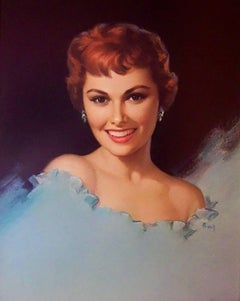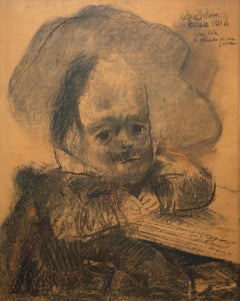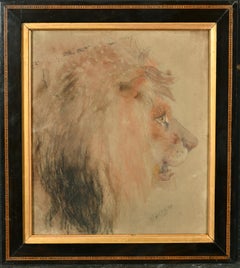Pearl Frush Art
to
1
1
1
Overall Height
to
Overall Width
to
1
1
1
1
1
1
1
1
1
6,997
3,373
2,513
1,212
1
1
1
1
Artist: Pearl Frush
Living Dream
By Pearl Frush
Located in Fort Washington, PA
Medium: Pastel on Illustration Board
Sight Size 18.50" x 23.50"; Framed 22.50" x 27.50"
Signature: Signed Lower Right
Shaw Barton Calendar Company
Category
Mid-20th Century Pearl Frush Art
Materials
Illustration Board, Pastel
Related Items
Dibujo a la manera de Velasquez (Drawing in the Manner of Velasquez)
By Fernando Botero
Located in Palm Desert, CA
A drawing by Fernando Botero. "Dibujo a la Manera de Velasquez" is a portrait, charcoal and pastel on cardboard in an earth-tone palette by Latin American artist Fernando Botero. It is signed upper right, "Sobre Velazquez Botero -1-27-60 Para Rita. el recuerdo de uno payaso".
Fernando Botero, best known for his voluptuously rotund human figures, was born in Medellín, Colombia on April 19, 1932. His father died when he was young, and he was raised by his mother, along with his two brothers. He attended a Jesuit school in Medellín and from the age of 12 to 14, he attended a matador training school. The bull fight became a recurring theme in Botero’s early work and while he was in his early teens, he sold his pictures of bull fights in front of the arena.
By the time he was 16 years of age, Botero was working as an illustrator for the local magazine El Colombiano. He also began writing articles about art theory, one of which, entitled Picasso and Non-Conformity in Art, led to his expulsion from the Jesuit school for its endorsement of Cubism. One of Botero’s important early works, Woman Crying...
Category
Mid-20th Century Post-War Pearl Frush Art
Materials
Charcoal, Pastel, Cardboard
19th century English chalk drawing on paper of a Lions head
By William Huggins
Located in Woodbury, CT
William Huggins was born in Liverpool, England on the 13th of May, 1820. His parents were Samuel and Elisabeth Huggins. He took his first drawing lessons from the Liverpool Mechanics...
Category
1840s Victorian Pearl Frush Art
Materials
Pastel, Paper
Free Shipping
H 11.75 in W 10 in
Portrait of George Arliss in Conte Crayon on Cardstock 1934
Located in Soquel, CA
Stately portrait of George Arliss by Ivan Opffer (Danish, 1897-1980). Mr. Arliss is depicted wearing his signature monocle, looking directly at the viewer. Although this piece appears to be done rapidly, there is a clear confidence in Opffer's work - he was an accomplished portrait artist - and the resemblance to the subject is unmistakable. George Arliss (born Augustus George Andrews; 10 April 1868 – 5 February 1946) was an English actor, author, playwright, and filmmaker who found success in the United States. He was the first British actor to win an Academy Award – which he won for his performance as Victorian-era British prime minister Benjamin Disraeli in Disraeli (1929) – as well as the earliest-born actor to win the honour. He specialized in successful biopics, such as Disraeli, Voltaire (1933), and Cardinal Richelieu (1935), as well as light comedies, which included The Millionaire (1931) and A Successful Calamity (1932).
Signed and dated "Ivan Opffer 1934" in the lower right.
Titled "Mr. Arliss" in the lower left.
Presented in a new off-white mat with foamcore backing.
Mat size: 22"H x 16"W
Art size: 17.5"H x 12"W
Ivan Opffer (Danish, 1897-1980) was born in Nyborg, Denmark, on June 4, 1897, to a family of Danish scholars and journalists. His brother was Emil Opffer, a Danish merchant seaman and journalist who was known for his relationship with American writer Hart Crane.
Ivan was raised in Mexico City and New York, where his anarchist father was the editor of a radical Danish-language newspaper. His involvement in painting and drawing began at an early age. At a summer workshop, he met and studied drawing with Winslow Homer, then went on to study at the National Academy of Design and the Art Students League of New York.
When the US entered World War I, Opffer was one of the members of the American Army Camouflage Corps, headed by Homer Saint-Gaudens (whose mother was a relative of Winslow Homer), the son of Augustus Saint-Gaudens. As a camoufleur, Opffer served with other artists and architects, some of whom became well-known, including Barry Faulkner, Sherry Edmundson Fry, Kimon Nicolaides, Robert Lawson, Abraham Rattner, Kerr Eby, and others.
It was this same unit, while still in training in at Camp American University in Washington DC, that launched a camp newspaper called The Camoufleur. Only three issues were published before the unit’s deployment to France in late 1917. In the October 31 issue, a satirical portrait by Opffer of Homer Saint-Gaudens (titled “Our Boss”) was published on page 5.
After the war, Opffer returned to New York, where he became known for his caricatures of leading Modern writers, among them James Joyce, Edgar Lee Masters, Siegfried Sassoon, George Bernard Shaw, Carl Sandburg, G.K. Chesterton, and Thomas Mann.
In the years between the wars, Opffer married Betty à Beckett Chomley, and settled in Paris, where he was a student at the Academie Julliard. He also lived in London and Copenhagen, where his drawings were frequently published in newspapers and magazines. With the outbreak of World War II, he and his family returned to New York and lived in Greenwich Village.
Among his friends in that era were William Butler Yeats, F. Scott and Zelda Fitzgerald...
Category
1930s American Impressionist Pearl Frush Art
Materials
Conté, Postcard, Illustration Board
H 22 in W 16 in D 0.25 in
Attributed J S Copley Two Nobles Portrait Paintings 18 century pastel parchment
Located in Florence, IT
On the cardboard applied on the frame there is an annotation, belonging to some of the old owners, reporting the names of the portrayed in Kurrent handwriting: "Urgroßvater Ludwig Fr(ei)h(e)r(r) von Keller" "Urgroßmutter Fr(ei)h(e)r(rin) von Keller geb(oren) von Niebecker". So we can deduce that the models were Ludwig Friedrich Heinrich Ferdinand Baron of Keller (1760-1835), a German politician who was the director of the district of Prussia, and his wife Auguste Johanne Henriette Baroness of Niebecker (1760-1832).
Their high class provenience is highlighted by the not contained expressive liveliness, by the proud pose imitating movement and by the elegance of the clothes which fabric seems palpable (especially sincere is the evanescent depiction of the pleated veil of the gorget and the adorned with arabesques decoration of the sleeves and the vest).
The two pieces can be attributed to John Singleton Copley...
Category
Late 18th Century Other Art Style Pearl Frush Art
Materials
Pastel, Parchment Paper, Cardboard
19th C. Newspaper Illustration of Hiram H. Hobbs, Foreman of the Grand Jury 1898
Located in Soquel, CA
Historical late 19th century portrait of Hiram H. Hobbs, Foreman of the Grand Jury of San Francisco y Richard Langtry Partington (American, ...
Category
1890s American Impressionist Pearl Frush Art
Materials
Illustration Board, India Ink
Abstract Silhouette Hat Portraits - Female Illustrator of Golden Age
By Jessie Gillespie
Located in Miami, FL
115 years after they were created, one can view these silhouettes differently than the artist’s intent.
After all, the genesis of this work was an editorial illustration for Life Magazine to showcase elaborate women’s hats.
They were done for a commercial assignment with a deadline, and picky editors were overseeing the final work.
Today, they have a dual meaning.
These charming silhouettes are abstractions as much as they are representations.
Moreover, each one is a compact little gem stuffed with observational detail.
Golden Age female illustrator Jesse Gillespie's mastery of technical skill, is apparent in minute details and composition.
Young women, old women, pendants, necklaces, feathers, and laced vails all contribute to the works understated complexity.
The identity of the subjects are revealed by small areas of exposed neck and chin.
As the viewers eyes goes from left to right - all six silhouettes read as fashion hieroglyphs in a sentence with a visual rhythm and cadence. .
Initialed JG lower right., Matted but not framed.
Published: Life Magazine, March 17th, 1910.
Provenance: Honey and Wax Bookstore
________________________________
From Wikipedia, the free encyclopedia
Jessie Gillespie Willing (March 28, 1888 – August 1, 1972) was an American illustrator during the Golden Age of illustration. She was considered the foremost silhouette illustrator of her time, although she did traditional illustration as well. Willing illustrated for books and magazines including Life, The Ladies' Home Journal, Woman's Home Companion, Mother and Child, McClure's Magazine, Childhood Education, the Sunday Magazine, Association Men (the magazine of the YMCA), Farm and Fireside, Every Week, Children: The Magazine for Parents (which became Parents Magazine), and the American Magazine. She is perhaps most well known for her work for the Girl Scouts.
Early life
Willing was born in Brooklyn on March 28, 1888 to John Thomson Willing (August 4, 1860 – July 8, 1947)[1][2] and Charlotte Elizabeth Van Der Veer Willing (December 1, 1859 – March 4, 1930).[3] Thomson Willing was a noted illustrator and art editor. He was also well known for finding new artistic talent. Jessie Willing was the eldest of three children. Her brother Van Der Veer (November 30, 1889 – January 14, 1919), who died of pneumonia at the age of 29, was an advertising agent.[4] Her sister Elizabeth Hunnewell Willing (July 26, 1908 – August 15, 1991) was one of the first women to graduate from the Philadelphia Divinity School.[5][6] Elizabeth married the Rev. Orrin Judd, rector of St. Mary's Episcopal Church, on September 22, 1931, and was active in church work.[citation needed]
The Willing family moved to the Germantown neighborhood of Philadelphia in 1901 or 1902. Jessie Willing attended the Stevens School, from which she graduated in 1905. She then went on to attend the Philadelphia Academy of Fine Arts from 1906 to 1907.[7][8]
Career
Willing used her middle name Gillespie as her professional surname. She also often signed her illustrations J.G.[9] The story goes that the art editor of Life magazine was in Thomson Willing's office when he was the art editor of the Associated Sunday Magazine syndicate. Thomson Willing had some of Jessie's artwork on his desk, which the Life editor saw and admired. He asked for the artist's information so that he could give her freelance work. Thomson Willing did not want to be accused of nepotism so he persuaded Jessie to use Jessie Gillespie as her professional name, which she did.[10][11]
In addition to her extensive illustration work, Willing was also the editor of Heirlooms and Masterpieces from 1922 to 1931 and the art editor of Jewelers' Circular-Keystone from 1933 to 1939.[12] She specialized in jewelry publicity and advertising. In 1966 she won the Gold medal of the Printing Week Graphic Arts Exhibit in Philadelphia for her Christmas catalog for J.E. Caldwell Co., Philadelphia.
Willing was a member of the Plastic Club of Philadelphia,[13] the American Institute of Graphic Arts (AIGA) and the National Arts Club of New York.[14] She was an honorary life member of the National Arts Club[15] and served on its Board of Governors from 1941-1970. In 1963, she received the Gold Medal of the National Arts Club in recognition of 32 years of selfless devotion.[15] Additionally, she was the national director of the American Institute of Graphic Arts (AIGA) from 1943 to 1946.[15] Previous to this she served as the Program Chairman of the AIGA and in that position she put together a travelling exhibit on the "history of narrative art from the first recorded picture story to the comic book of the twentieth century."[16][17]
Illustrations in books
With Tongue and Pen--Frederick Bair, et al. (MacMillan, 1940)
Masoud the Bedouin--Alfred Post Carhart (Missionary Education Movement, 1915)
The Path of the Gopatis--Zilpha Carruthers (National Dairy Council, 1926)
The Schoolmaster and His Son: A Narrative of the Thirty Years War--Karl Heinrich Caspari (Lutheran Publication Society, 1917)
On a Rainy Day--Dorothy Canfield Fisher and Sarah Scott Fisher (A.S. Barnes and Co., 1938)
Book of Games for Home, School and Playground--William B. Forbush and Harry R Allen...
Category
1910s Victorian Pearl Frush Art
Materials
Ink, Illustration Board, Pen
H 4.25 in W 20.5 in D 1 in
DeBeers Diamonds Graphic Drawing by Bernard Nacion
Located in Larchmont, NY
Bernard Nacion
Untitled (DeBeers), Late 20th Century
Mixed media on artist board
19 3/4 x 15 in.
This illustration shows a woman wearing a sparkling diamond wedding ring, framed wit...
Category
Late 20th Century Contemporary Pearl Frush Art
Materials
Pastel, Ink, Mixed Media, Watercolor, Board
Dance at the Dream Bar
By Sylvestre Bruly Bouabré
Located in New York, NY
Dance at the Dream Bar
Category
21st Century and Contemporary Pearl Frush Art
Materials
Pastel
"Man, How Did They Know Me?" Oil Pastel on Illustration Board by Reginald K. Gee
By Reginald K. Gee
Located in Milwaukee, WI
"Man, How Did They Know Me?" is an original oil pastel drawing on illustration board by Reginald K. Gee. The artist signed the piece on the back. It features a few abstract portraits...
Category
1990s Contemporary Pearl Frush Art
Materials
Oil Pastel, Illustration Board
Portrait - Original Pastel and Charcoal by Fernand Renault - Early 20th Century
By Albert Fernand-Renault
Located in Roma, IT
Portrait is a beautiful drawing in pastel and charcoal on paper realized by Fernand Renault (1865-1909)
In good condition.
Stamped on the lower right.
The artwork represents the p...
Category
Early 20th Century Modern Pearl Frush Art
Materials
Charcoal, Pastel
H 22.05 in W 16.54 in D 0.04 in
Apocalypse, Catastrophic Destruction of the World, Surrealism - Life Magazine
Located in Miami, FL
Apocalypse in 1962? At the height of the Cold War, Life Magazine commissions an illustration that describes the world's end by means other than a nuclear war with Russia. Richard Erdoes brilliantly illustrates the work with his highly stylized painting technique. My favorite part of the work is on the left side showing a group of people packed together as they fall into oblivion. A clear reference would be Hieronymus Bosch's "The Last Judgment "
Once Again the World Ends." Illustration published in Life Magazine, Feb. 9, 1962
Signed in lower right image.
Unframed
Richard Erdoes (Hungarian Erdős, German Erdös; July 7, 1912 – July 16, 2008) was an American artist, photographer, illustrator and author.
Early life
Erdoes was born in Frankfurt,[1] to Maria Josefa Schrom on July 7, 1912. His father, Richárd Erdős Sr., was a Jewish Hungarian opera singer who had died a few weeks earlier in Budapest on June 9, 1912.[2] After his birth, his mother lived with her sister, the Viennese actress Leopoldine ("Poldi") Sangora,[3] He described himself as "equal parts Austrian, Hungarian and German, as well as equal parts Catholic, Protestant and Jew..."[4]
Career
He was a student at the Berlin Academy of Art in 1933, when Adolf Hitler came to power. He was involved in a small underground paper where he published anti-Hitler political cartoons which attracted the attention of the Nazi regime. He fled Germany with a price on his head. Back in Vienna, he continued his training at the Kunstgewerbeschule, now the University of Applied Arts, Vienna.[5] He also wrote and illustrated children's books and worked as a caricaturist for Tag and Stunde, anti-Nazi newspapers. After the Anschluss of Austria in 1938 he fled again, first to Paris, where he studied at the Academie de la Grande Chaumiere, and then London, England before journeying to the United States. He married his first wife, fellow artist Elsie Schulhof (d. xxxx) in London, shortly before their arrival in New York City.
In New York City, Erdoes enjoyed a long career as a commercial artist, and was known for his highly detailed, whimsical drawings. He created illustrations for such magazines as Stage, Fortune, Pageant, Gourmet, Harper's Bazaar, Sports Illustrated, The New York Times, Time, National Geographic and Life Magazine, where he met his second wife, Jean Sternbergh (d. 1995) who was an art director there. The couple married in 1951 and had three children.[6] Erdoes also illustrated many children's books.
An assignment for Life in 1967 took Erdoes to the Pine Ridge Indian Reservation for the first time, and marked the beginning of the work for which he would be best known. Erdoes was fascinated by Native American culture, outraged at the conditions on the reservation and deeply moved by the Civil Rights Movement that was raging at the time. He wrote histories, collections of Native American stories...
Category
1960s Surrealist Pearl Frush Art
Materials
Mixed Media, Illustration Board, Board, Gouache
H 7.5 in W 14.25 in D 1 in
Portrait - Original Mixed Media Artwork by Maurice Lourday - 1927
Located in Roma, IT
Portrait is an original pencil, pastel and watercolor drawing on creamy cardboard, realized in 1927 by Maurice Lourday (1860-1934).
Titled on the lower.
In very good conditions, ex...
Category
1920s Contemporary Pearl Frush Art
Materials
Cardboard, Watercolor, Pencil, Pastel
H 11.82 in W 9.45 in D 0.04 in
Pearl Frush art for sale on 1stDibs.
Find a wide variety of authentic Pearl Frush art available for sale on 1stDibs. Not every interior allows for large Pearl Frush art, so small editions measuring 24 inches across are available. Customers who are interested in this artist might also find the work of Alessandra Maria, Robert Philipp, and David Edward Byrd . Pearl Frush art prices can differ depending upon medium, time period and other attributes. On 1stDibs, the price for these items starts at $6,500 and tops out at $6,500, while the average work can sell for $6,500.


